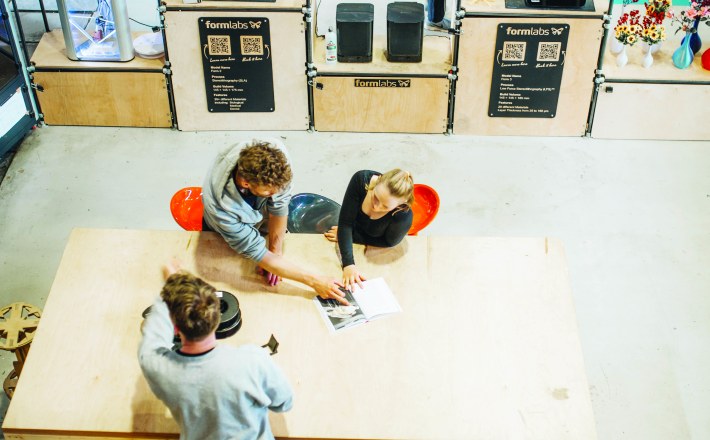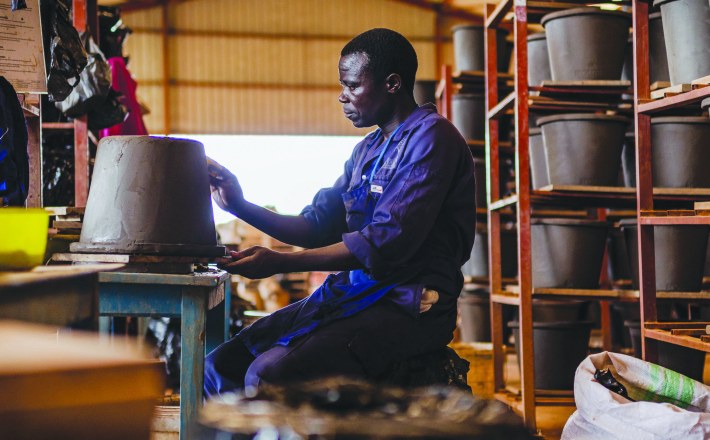Timber
Rick Jordan charts the resurgence of wooden architecture in our urban landscapes from plyscrapers to carbon negative structures
In the small northern Swedish town of Skelleftea, a municipality entirely run on renewable energy, children attend classes in a wooden school, while their parents park in a wooden multi-storey car park. The air traffic control tower is wooden, as is the town’s cultural centre, home to an expansive timber auditorium, as well as a hotel that rises 20 storeys high. Over in Norway, meanwhile, on the shores of its largest lake in the otherwise unremarkable town of Brumunddal, is another timber tower. From a distance it looks as if it’s been constructed from Jenga bricks; walk closer and you can see the lines of wood grain and knots on its surface. Step inside, and bare floorboards lead to a restaurant filled with wooden tables and chairs, illuminated by wooden lampshades. The food, it should be noted, is not made of wood.
These might sound like something from the pages of a children’s book by Richard Scarry or a utopian vision of sustainability in the year 2100, but they are – if you excuse the expression – a very concrete reality. After centuries of being overshadowed by man-made materials such as steel, bricks, cement, glass and reinforced concrete, wooden urban architecture is most definitely on the rise as timber takes centre stage again.
Using wood as a building material, of course, is nothing new. Recently uncovered archaeological evidence in Zambia has shown that the earliest wooden structures date back almost half a million years, before we evolved into homo sapiens. By around 9,000BC, wooden longhouses were providing shelter for Stone Age settlements, while the world’s oldest surviving wooden building is the Horyuji temple in Japan’s Nara prefecture, crafted from cypress in 607AD and still standing strong.
Wooden urban architecture is on the rise
It’s this sheer resilience that makes wood such a desirable material. When the Three Little Pigs of popular fable fame jettisoned their stick-built house for a brick one, it wasn’t the materials to blame but their technique. A game-changer in the evolution of wooden architecture has been the adoption of two materials: glued laminated timber (made from layers of wood bonded together), which has a higher load-bearing capacity than both steel and concrete; and cross-laminated timber (CLT), a sort of over-sized plywood, with layers stuck at right angles making it strong in all directions. Concrete, steel and glass are still used, but in far smaller quantities than conventional high-rises.
This is why wooden skyscrapers, or plyscrapers as they’ve been nicknamed, are rising with increasing frequency on our skylines. In 2020, the HoHo Tower was completed in Vienna, measuring 84 metres, while the 65-metre tall Roots residential building is underway in Hamburg’s HafenCity district, and in Berlin, the WoHo building (short for Wohnhochhaus) near Potsdamer Platz will be 98 metres, topped with a roof garden. The current title-holder for tallest timber tower is the Ascent tower in Milwaukee (86 metres), though that’s set to be dwarfed by the Atlassian Headquarters in Sydney – a mighty 180 metres – and then by the just-approved C6 building in Perth, at 191.2 metres and 50 storeys. How high can you go? A century after property magnates competed to out-do each other in New York, throwing up landmark buildings such as the Chrysler and Empire State, we’re seeing a new race to the sky.

There are other benefits, of course. Mass timber can be left exposed to the elements, doing away with plastering and decorating – and therefore speeding up the building process. The Sara Culture Centre, for example, would have taken another year to complete had no timber been used. It’s also lighter, requiring smaller foundations, and quieter to work with – resulting in a less stressful work environment. And despite what you might think, timber is surprisingly resistant to fire, as the outer surface burns but creates a protective charred layer on top.
‘It’s also very easy to work with,’ Marshall Blecher, co-founder of Denmark-based MAST, tells me. His studio specialises in using wood for floating and water-facing designs such as the Sauna KFF project and Platform C viewing platform in Copenhagen; the Nordhavn sauna club it designed in the same city is a beautiful structure of exposed wood set around a courtyard, topped by a living roof and with large windows opening onto the water. ‘Using robotically cut panels you can achieve extreme precision over a large building. And it’s far more flexible and adjustable than other materials, so you can easily make changes further down the line.’

The biggest advantage of wood is sustainability
The biggest advantage, though, is sustainability. As James Dibble of Grange Development, the developer behind the C6 building, says, ‘You can’t grow concrete.’ For the Perth plyscraper, timber will be harvested from 600 trees, making it Western Australia’s first carbon-negative building. A 2018 report by Chatham House estimated that cement production accounted for eight per cent of global carbon emissions; any concrete waste goes to landfill, whereas timber can easily be recycled. ‘It’s a blueprint that utilises hybrid construction to offset the carbon within our built environment, which is the single biggest contributor to climate change,’ adds Dibble. Similarly, Sweden’s Sara Cultural Centre, which has been nominated for the 2024 Mies van de Rohe Awards, was crafted from trees taken from the landscape around it, which together sequester thousands of tonnes of carbon.
The architectural studio responsible, White Arkitekter, is studying how far they could transport the building without undoing its carbon saving – partner Robert Schmidt reckons it could go twice around the world and still be carbon neutral. ‘Even if you burn the components of a house after 50 years, releasing the captured carbon back into the air, it will still be significantly better than masonry or steel building,’ says Marshall Blecher. ‘Although I don’t know quite how sustainable it would be were all buildings to be made from timber. Would we have enough resources?’

But you don’t have to aim high to make a statement with wood. Timber is being used for grand-scale projects of all shapes and sizes. In summer 2024, all eyes will be on the Paris Olympics. There will be a world-beating performance behind the scenes too. The Games are aiming to be the greenest in recent history, cutting carbon emissions by half compared to the 2020 ones in Tokyo. This is partly being achieved by upcycling and using existing venues in the city, such as the timber-framed Champs de Mars Arena (under French law, all new public buildings must use timber as their primary building material). Only the temporary athletes’ villages and permanent aquatic centre will be constructed afresh, both from timber; the latter designed as an undulating cathedral to sport, capped by a roof just 50cm in diameter and solar panels that will form the largest urban photovoltaic farm in France.
Meanwhile, in Italy, Kengo Kuma, a Japanese architect with a love of natural materials and forms, is currently realising his Welcome Project in Milan, using timber and vegetation to create what he’s described as the post-Covid, biophiliac office of the future. More horizontal than vertical, it will be filled with open spaces and hanging gardens, set around angular jutting timber roofs and walkways. ‘We are facing a revolution of urban design,’ Kuma says; ‘and wood can make this revolution happen.’

So wood is durable, and can be immensely strong; it can be nailed and bent and carved and planed, and constructed to dizzying heights; but it’s also a very emotive, warm material. We respond to it in a way that we simply don’t with concrete or steel. ‘I’ve always loved wooden buildings,’ Blecher tells me during a trip to Japan. ‘I grew up in a cabin in the woods built by my hippie father in Australia. It’s a beautiful material that ages gracefully and patinates nicely. I recently stayed in a 200-year-old wooden house in Tokyo, one of the few left, and it was just superb. It smelled nice, and looked great. I never get that in a modern house made from composite materials. Wood has soul.’





